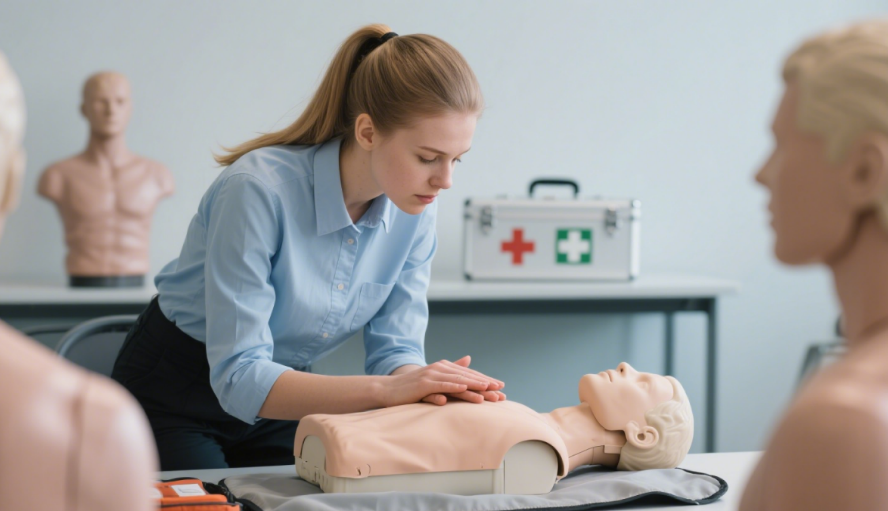Emergencies can occur unexpectedly at any time and in any place. It could be a sudden cardiac arrest on a crowded sidewalk, a drowning mishap at a swimming pool, or an accident within a workplace. In such critical moments, knowing how to perform cardiopulmonary resuscitation (CPR) can be the determining factor between life and death. Hence, enrolling in a CPR course is not merely an option but an essential step for everyone.
Understanding CPR Basics
CPR is a combination of chest compressions and rescue breaths that aim to keep the blood flowing and oxygen reaching the vital organs when a person’s heart has stopped beating or is not pumping effectively. The technique has evolved over the years, with the current guidelines emphasizing the importance of high-quality chest compressions. A proper chest compression involves pushing hard and fast on the center of the victim’s chest, at a rate of at least 100 to 120 compressions per minute. Rescue breaths, depending on the situation and the type of CPR being performed (such as for adults, children, or infants), are also carefully administered to supply oxygen to the lungs.
When a person experiences cardiac arrest, every second counts. Brain cells start to die within just a few minutes without a continuous supply of oxygenated blood. By starting CPR immediately, bystanders can significantly increase the chances of the victim’s survival until professional medical help arrives. For example, in many cases where CPR was initiated promptly at the scene of a cardiac event, the patient was able to recover better after receiving further treatment in the hospital.
The Benefits of Taking a CPR Course
Taking a CPR course offers numerous benefits. Firstly, it equips individuals with the knowledge and skills needed to act confidently in an emergency situation. Many people are hesitant to help when they witness an emergency simply because they don’t know what to do. However, those who have completed a CPR course have a clear understanding of the steps and can spring into action without hesitation.
Secondly, CPR courses are designed to be accessible to people of all ages and backgrounds. They are available in various formats, including in-person classes at community centers, hospitals, or training facilities, as well as online courses with hands-on practice sessions. This flexibility allows more and more people to fit the learning into their busy schedules. Whether you’re a student, a working professional, a parent, or a retiree, you can find a CPR course that suits you.
Moreover, having a large number of people trained in CPR in a community can have a significant impact on the overall survival rates from cardiac arrests. When more bystanders are able to perform CPR, the “chain of survival” is strengthened. The chain of survival includes early recognition of the emergency, early CPR, early defibrillation (using an automated external defibrillator if available), and early advanced medical care. Each link in this chain is vital, and CPR plays a central role in keeping the victim alive until the other components can be implemented.
Different Types of CPR Courses
There are different types of CPR courses tailored to specific needs. For instance, the basic CPR course for the general public focuses on teaching the fundamental skills of chest compressions and rescue breaths for adults, children, and infants. It usually includes practical training on manikins to ensure that participants can perform the techniques correctly.
Then there are advanced CPR courses for healthcare providers. These courses go into more depth about the physiology behind cardiac arrest, different scenarios that might be encountered in a medical setting, and how to work as a team during a resuscitation effort. Healthcare workers such as doctors, nurses, paramedics, and emergency medical technicians are required to regularly update their CPR certifications through these advanced courses to maintain their proficiency.
There are also specialized CPR courses for specific occupations like lifeguards, who need to be proficient in water rescue and performing CPR in aquatic environments. And for teachers and school staff, there are courses that focus on dealing with emergencies among students in an educational setting.
The Impact on Society
The widespread availability and completion of CPR courses can have a profound impact on society as a whole. In many countries, initiatives are being taken to increase the number of people trained in CPR. For example, some cities have organized mass CPR training events in public spaces to encourage citizens to learn this life-saving skill. When more people in a community know CPR, the chances of a successful outcome in an emergency situation increase exponentially.
From a public health perspective, it can reduce the burden on the healthcare system. Fewer patients suffering from severe brain damage or death due to delayed CPR means that there will be less need for long-term and costly medical care. Additionally, it creates a culture of preparedness and caring, where individuals feel empowered to help others in need.
In conclusion, a CPR course is an investment in life. It gives us the power to make a difference when it matters the most. Whether it’s saving the life of a loved one, a neighbor, or a stranger on the street, the skills learned in a CPR course can turn an otherwise tragic situation into one with hope and a positive outcome. So, don’t hesitate. Sign up for a CPR course today and become part of the life-saving community that is working towards a safer and more resilient world.
